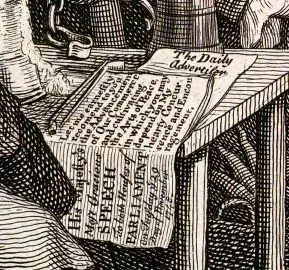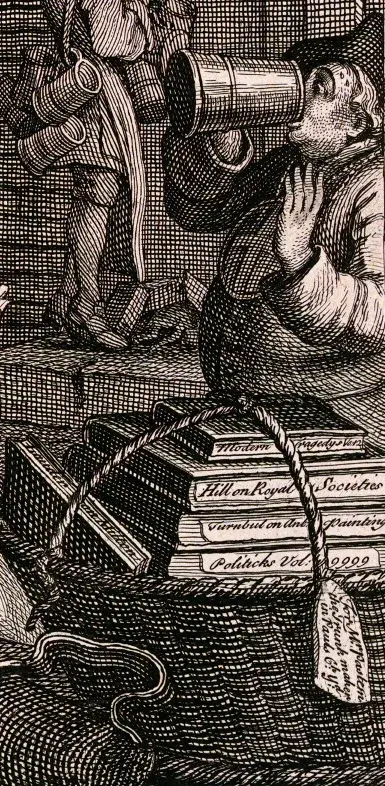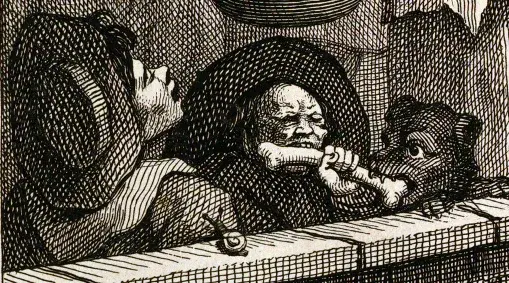Introduction

For this research task I managed to find a high-resolution copy of both images. This allowed me to zoom in closer to take note of some of the finer details. I found it amazing how much detail and messaging Hogarth managed to include in the images. They go so much further than the accompanying poems achieve.
At first, I started to make notes in my sketchbook about the combinations of denotation and connotation in the images. I quickly realised that I would end up using pages and pages which I would then have to write up! So I changed the way I organised the task, using tables in the learning log itself to note my observations and thoughts. I took selected areas of the images where useful to contextualise what I was comparing.
The table approach was probably the most efficient way for me to do this. I like to deconstruct and analyse work as part of my research tasks, but had I taken more usual narrative-driven approach I think this particular task could have become overwhelming for me and the reader!
Below I have called out different sections, and for each compared the denotation and connotation present. Hopefully this makes it easier to digest, and I hope you find it as interesting as I did! I do wonder how much connotation is influenced by my own morality, assumptions and socio-economic views. Not that I agree with Hogarth - more that I see the demonisation of the working classes still at play in modern times, and these images seem to reflect media tactics of right-wing political parties in today's society.
Beer Street
Pub Sign

Denotation | Connotation |
Foreground position | Importance - detail Hogarth wants you to see |
Pub sign title - "Health to the Barley Mow" |
|
There is a pub here | A sanctioned, reputable place to enjoy alcohol |
Artist
Denotation | Connotation |
Thinner physique | Does not eat as much |
Tattered clothing | Cannot afford to make new or mend (or simply does not care). Combined with physique is this a depiction of the 'starving artist' trope? |
Art palette & brushes | Spends his money on his tools and not himself, his craft is what is important to him |
Hanging bottle | He is using reference for the sign he is painting, he takes pride in his work |
Smiling face | He is happy in his work [despite any negative aspects above]. |
Foregrouond position | Hogarth wants us to take note (to show variety of occupations when seen with traders below?) |
Traders

Denotation | Connotation |
Foreground position | Important (directly supports the poem below) |
Portly physique and happy demeanour | They have plenty to eat and are happy in their work and lives |
Well-maintained clothing, with tools about their persons | These are reputable tradesmen, and are respectable |
Fishwives |
|
Key held by fishwife  | Keys are often symbols of freedom and access/membership (e.g. to a merchant guild). This infers the fishwife has personal and commercial freedom. |
Newspaper reporting on speech from the King linking commerce and "the art of peace"  | Healthy, regulated trade is key to proper society, and is supported by the King as well as both houses of Parliament |
Large meat joint and baskets full of fish and vegetables | Merchants who drink beer are prosperous |
Cleric drinking beer from a tankard on his way to deliver books (on politics, classic tragedies, painting and socio-economics) to a trunk maker in the city.  |
|
The Pawn Broker

Denotation | Connotation |
Hand receiving beer through hatch.  |
|
The Pawnbroker's building is dilapidated and in need of much repair | Business is very poor for the pawnbroker |
Pawnbroking sign is hanging down off of the building | Business is very poor for the pawnbroker
|
Other notes: | The arrow is also a very useful device to aid the visual scanning of the picture, it directs the viewer's gaze from the foreground to the background information. |
Background Buildings

Denotation | Connotation |
Background position | less important specific information, but provides overall context and setting |
The buildings are tall, in good repair, and structured in an ordered manner | This is a civilised, well-managed place to live and do business. There is wealth and prosperity |
Union Flag | The people who live and work on Beer Street are loyal and proud Britons |
Sun sign | Suns are symbols of light and positivity. |
Scaffolding on building | There is regeneration and/or growth. It is a living, breathing part of the city. |
Builders drinking beer on the rooftops | These builders have the time to stop and drink beer together. The working conditions here must be favourable. |
Sedan

Denotation | Connotation |
Woman passenger in an opulent dress | The wealthy visit Beer Street |
Man with musket standing nearby, with weapon ported in his right arm | This is a safe location, the bodyguard is not worries about anyone attacking his charge. |
Footmen taking a break to drink beer | Carrying the large woman is hard work, and is rewarded by drinking beer. The passenger is not objecting, which implicitly condones the behaviour. |
Gin Lane
The Gin House

Denotation | Connotation |
Foreground position | Has detail of import that author wants you to see first |
Entrance is an underground arch |
|
Inscription above the door tells people how cheap it is to drink, and they provide clean straw. |
|
The gin sill hangs above the archway as an advertisement to enter the premises |
|
The Starving Man

Denotation | Connotation |
Sits on the bottom right of the image | Compositionally, acts as a direct mirror to the happy, plump merchants of Beer Street |
Man is wearing ill-fitting clothing, which hangs off of his emaciated body. | Gin is addictive, so much so that you would rather spend your money to buy gin than feed and nourish yourself |
The man is unconscious | People who drink gin inevitably end up unconscious in a drunken stupor |
His shirt is missing | Gin addicts end up selling even the shirt off of their own back in order to fuel their habit |
The dog is looking at the empty glass | Even simple animals realise the cause of his stupor, and are not stupid enough to partake. |
There is is a story named "The Downfall of Madam Gin" |
|
Notes: | There seems to be a lot of parallels with the contemporary narratives and stigma of substance abuse addicts (e.g. heroin) |
Drunk Woman

Denotation | Connotation |
Foreground central position | Has a lot of primary visual information that Hogarth wants the viewer to take in |
Sits on the steps down to the gin house | Has no self respect as to where they are |
Minimal clothing, in poor repair. No visible shoes. | Is poor, with no money for new or repairing her clothes |
Her breasts are showing, her child is falling over the railing and she does not seem to notice or care. |
|
She has lesions on her legs and face |
|
She is taking something out of a tin | Possibly a snuff box? Suggests connotation that gin use is linked to other substance use. |
Mother and Children
Denotation | Connotation |
Mother feeding gin to baby  | Gin is drunk by poor mothers, who raise the next generation of gin addicts |
Children gnawing on bone next to a dog  |
|
Pawnbroker

Denotation | Connotation |
|---|---|
The building is foreground, on the left of the image | Compositionally a mirror to Beer Street, however it is more prominent suggesting more importance within the location |
The sellers have tattered clothing | The seller are poor and in need of money to buy more gin |
They are selling pots, pans, a good coat and tools | They place a higher value on getting drunk on gin than they do looking after themselves, having self-respect and putting in hard work to earn money |
The pawnbroker is visible, appraising the goods. He wears expensive-looking clothes and a wig. |
|
The building is strong, sturdy and in excellent condition, an expensive-looking vase sits in the window |
|
The sign is in good repair, hanging from the wall of the building | The perspective provides the arrow-like pole to sit on the page in an upwards direction, a metaphor for success? |
Crowds

Denotation | Connotation |
Crowd of people fighting, many have injuries or impairments |
|
Man being carried in wheelbarrow while been fed gin | Gin encourages antisocial behaviour, and the abuse of tools that could/would have otherwise been used for productive work |
Man stealing bellows while also running away with a giant pin that is skewering a child(!) | Gin is drunk by criminals, murderers and deviants |
Distillery

Denotation | Connotation |
Distillery is open, housing many barrels of gin. | This is not a reputable drinking establishment, and is little more than a warehouse |
The distillery seems to be in good repair | Distilleries are making a good amount of money |
The distillery is run by a "Mr. Kilman" | This seems like a thinly-veiled play-on-words. Kilman = Kill man. Gin kills men. |
Background scene

Denotation | Connotation |
Buildings are disordered | Gin leaves chaos in it's wake, it destroys structure and order. |
Buildings are in very poor repair, many have collapsed or are in the process of crumbling. | There is no money to look after buildings People are so drunk all the time, they forget to look after buildings, their homes and community |
There is the steeple of St George's Church, Bloomsbury in the distance. (This would place the scene close to the current location of Drury Lane) | All the figures in this scene face the viewer: literally and metaphorically turning their back on the nearby church. They turn away from Godly behaviours. |
A sign denotes the presence of an undertakers. They operate in the street, placing a dead woman in a coffin while her child weeps on the floor. |
|
A dead man hangs by the neck inside a ruined building  | Drinking gin leaves you destitute and depressed enough to take your own life |
A modern re-interpretation

While I was researching this topic, I came across this satirical illustration by Neal Fox made for the Sunday Times. It parodies the rise in popularity of gin in more modern times, alongside other aspects of 'hipster' culture. I think intent in this illustration is to poke fun at the way that something that was the vice of the working class has become a niche luxury of the middle class.
In this regard, I think the illustration is successful. However, on the whole I think the illustration has lost all of the sub-text and nuance of the original. It seems to play entirely on the denotation of gentrification. It has little of the subtle metaphor that Hogarth's original achieves so well.
References
Fox, N. (no date) Gin Lane Revisited, Fine Art Prints by Neal Fox. Available at: https://nealfox.bigcartel.com/product/gin-lane-revisited (Accessed: 07 October 2023).
Hogarth, W. (2020) Beer Street, Gin Lane, Wikipedia. Available at: https://en.wikipedia.org/wiki/Beer_Street_and_Gin_Lane (Accessed: 07 October 2023).
Wikisource contributors (2023) ‘Pawnbroking’, in 1911 Encyclopædia Britannica. Available at: https://en.wikisource.org/w/index.php?title=1911_Encyclop%C3%A6dia_Britannica/Pawnbroking&oldid=9275649 (Accessed: 07 October 2023).



Opmerkingen